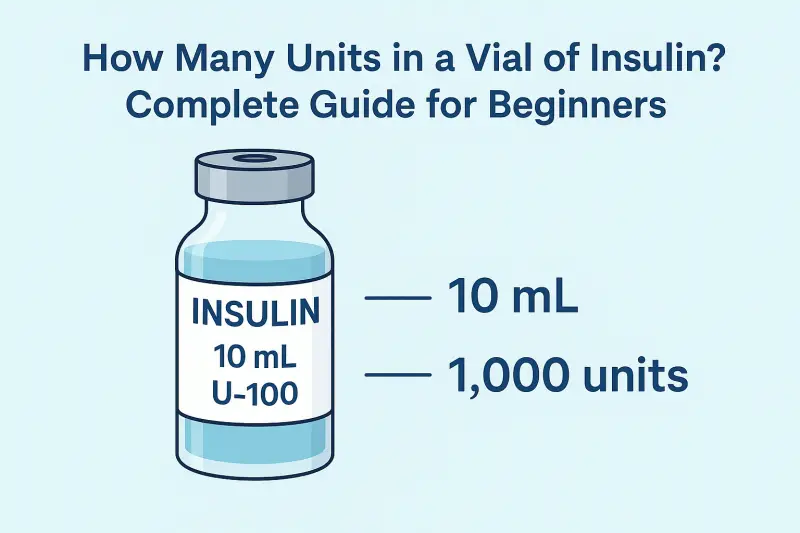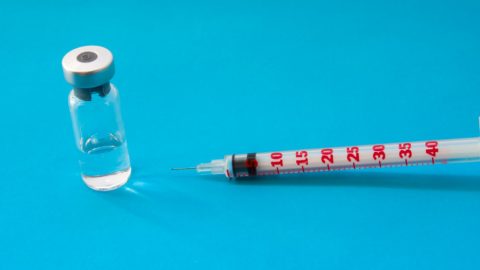If you’ve just started using insulin or caring for someone who does, you might be wondering one common question — how many units are in a vial of insulin? This question is essential because understanding insulin dosage and measurement ensures proper blood sugar control and safety.
Insulin vials come in different sizes and concentrations, and these differences can be confusing for beginners. Some vials contain 100 units per milliliter, while others may have higher or lower concentrations depending on the type and brand. Knowing the difference can help you avoid dosing mistakes and manage diabetes effectively.
This guide will explain how insulin vials are labeled, how many units they contain, how to calculate doses, and the right way to store and use them. Whether you are new to insulin therapy or want a refresher, this article will give you everything you need to know.
Understanding Insulin Concentrations

Insulin is measured in units, not milliliters or milligrams. A unit represents a standard biological measure of insulin’s activity, and it’s crucial to understand the concentration printed on your insulin vial label.
What Does “U-100” Mean?
Most insulin used today is U-100 insulin, which means it contains 100 units of insulin per milliliter (mL) of fluid. Since a standard vial has 10 mL of liquid, this equals:
10 mL × 100 units/mL = 1,000 units per vial
So, if you use standard U-100 insulin, one vial contains 1,000 total units.
Other Insulin Concentrations
While U-100 is the most common, other insulin concentrations exist to accommodate different needs:
- U-40 insulin: 40 units per mL (commonly used for pets, not humans)
- U-200 insulin: 200 units per mL (found in some insulin pens)
- U-300 insulin: 300 units per mL (available in long-acting forms like Toujeo)
- U-500 insulin: 500 units per mL (used for people with severe insulin resistance)
Each concentration requires the correct syringe or pen to ensure accurate dosing. Using the wrong syringe for a different insulin strength can result in a dangerous overdose or underdose.
How Many Units Are in a Vial of Insulin?
U-100 Insulin Vial
A standard U-100 insulin vial contains 10 mL of solution. Since there are 100 units per mL, that makes 1,000 total units per vial.
If your doctor prescribes 30 units per day, a single vial will last approximately:
1,000 units ÷ 30 units/day = about 33 days
U-200 and U-300 Concentrations
For concentrated insulins, the total number of units per vial increases proportionally. However, most highly concentrated insulins like U-200 and U-300 are available only in pens, not traditional vials.
Still, understanding the math helps you recognize dosing differences:
- U-200 insulin: 200 units/mL × 10 mL = 2,000 total units per vial (hypothetical example)
- U-300 insulin: 300 units/mL × 10 mL = 3,000 total units per vial
Always check your label carefully, especially if switching insulin types.
Types of Insulin and Their Vials
Different types of insulin are available for various purposes. Each type can come in vials with specific concentrations.
1. Rapid-Acting Insulin
- Examples: Humalog (Lispro), Novolog (Aspart), Apidra (Glulisine)
- Onset: 10–15 minutes
- Duration: 3–5 hours
- Vial size: 10 mL, U-100 (1,000 units total)
- Use: Before meals to control post-meal blood sugar spikes
2. Short-Acting Insulin (Regular)
- Examples: Humulin R, Novolin R
- Onset: 30 minutes
- Duration: 5–8 hours
- Vial size: 10 mL, U-100 (1,000 units total)
- Use: Taken before meals, slower than rapid-acting types
3. Intermediate-Acting Insulin (NPH)
- Examples: Humulin N, Novolin N
- Onset: 1–2 hours
- Duration: 12–18 hours
- Vial size: 10 mL, U-100 (1,000 units total)
- Use: Provides baseline insulin coverage
4. Long-Acting Insulin
- Examples: Lantus (Glargine), Levemir (Detemir), Tresiba (Degludec)
- Onset: 1–2 hours
- Duration: Up to 24 or more hours
- Vial size: 10 mL, U-100 (1,000 units total)
- Use: Maintains steady insulin levels throughout the day
How to Measure Insulin Units
Insulin doses must be measured precisely. The tools you use depend on the form of insulin you’re taking.
Using Insulin Syringes
If you use a vial, you’ll need an insulin syringe. These syringes are marked in units to match the insulin concentration.
For example:
- A U-100 syringe is used for U-100 insulin.
- A U-40 syringe is used for U-40 insulin.
A U-100 syringe comes in three common sizes:
- 30-unit syringe (0.3 mL)
- 50-unit syringe (0.5 mL)
- 100-unit syringe (1.0 mL)
Each syringe has fine unit markings for accurate measurement. Always match your syringe type with your insulin vial concentration.
Using Insulin Pens
Insulin pens come prefilled with insulin and allow you to dial the exact number of units. They’re simpler and safer for many users, reducing dosing errors. Each pen delivers a fixed amount per “click,” depending on the model and concentration.
How Long Does a Vial of Insulin Last?
Opened Vial
Once opened, an insulin vial generally lasts 28 days when stored properly at room temperature (below 86°F or 30°C). After 28 days, insulin may lose potency, leading to less effective blood sugar control.
Unopened Vial
An unopened vial can be stored in the refrigerator (36°F–46°F or 2°C–8°C) until its expiration date. Always check the label before use, and never freeze insulin — freezing destroys its effectiveness.
Calculating Vial Duration
To estimate how long your vial lasts, divide the total units by your daily dose:
1,000 units ÷ daily units = number of days
For example:
- 20 units/day → lasts 50 days
- 40 units/day → lasts 25 days
- 60 units/day → lasts 16 days
Remember to account for potential dose adjustments and wastage during priming or injection.
How to Store Insulin Vials Properly
Proper storage is vital to keep insulin effective and safe.
Before Opening
- Keep vials refrigerated between 36°F and 46°F (2°C–8°C).
- Avoid freezing; discard if insulin has frozen.
- Keep away from direct sunlight or heat sources.
After Opening
- Store the opened vial at room temperature (below 86°F or 30°C).
- Do not return it to the refrigerator after it has been used.
- Label the vial with the opening date.
- Discard after 28 days, even if there is insulin left.
Improper storage can cause insulin to clump, crystallize, or lose potency. Always inspect the liquid — if it looks cloudy (when it shouldn’t be), has particles, or changes color, discard it.
Tips for Handling Insulin Vials
- Wash your hands before every injection.
- Roll cloudy insulin gently between your palms (e.g., NPH type) before drawing it up — never shake.
- Use a clean syringe every time to avoid contamination.
- Draw insulin correctly: insert the needle into the rubber stopper, push air into the vial (equal to your dose), then draw out insulin.
- Check for air bubbles and tap the syringe gently to remove them.
- Inject at the recommended site — abdomen, thigh, or upper arm.
- Rotate injection sites to avoid lipodystrophy (thickened or scarred skin).
- Never share vials or syringes with others.
Common Mistakes to Avoid
- Mixing up insulin types: Always double-check the label and appearance before injection.
- Using the wrong syringe: U-40 and U-100 syringes are not interchangeable.
- Skipping doses: This can cause blood sugar spikes and health complications.
- Reusing syringes: Increases infection risk and dulls the needle.
- Improper storage: Heat or freezing ruins insulin’s structure and potency.
Learning the correct way to use and store insulin ensures that every dose is safe and effective.
FAQs About Insulin Vials
1. How many units are in a 10 mL vial of insulin?
A standard U-100 insulin vial contains 1,000 units (100 units per mL × 10 mL).
2. How many doses are in a vial of insulin?
This depends on your prescribed dose. For example, if you take 25 units per injection twice a day (50 total units), one vial will last about 20 days.
3. Can I mix different types of insulin in one syringe?
Only mix insulin if your doctor instructs you to. Some types (like NPH and regular insulin) can be mixed safely, while others should never be combined.
4. What happens if I use expired insulin?
Expired insulin may not work effectively, leading to poor blood sugar control. Always check the expiration date and discard after 28 days of opening.
5. Can I travel with insulin vials?
Yes. Keep insulin in a cool, insulated bag, away from direct sunlight. Always carry a spare vial and your prescription when flying.
When to Replace Your Insulin Vial
Replace your vial if:
- It’s past 28 days since opening.
- It has been exposed to heat or frozen.
- You notice changes in color, consistency, or particles.
- You have uncertain storage conditions (e.g., lost power during refrigeration).
Never take chances with compromised insulin — ineffective doses can result in dangerously high blood sugar levels.
Insulin Cost and Insurance Coverage
Insulin prices can vary widely depending on the brand, type, and location. A 10 mL vial of U-100 insulin typically costs between $25 and $300 in the U.S. without insurance.
Many insurance plans, pharmacy programs, and patient-assistance programs can help lower costs. Some manufacturers also offer discount cards or copay assistance for those who qualify. Always check with your doctor or pharmacist for options to make insulin more affordable.
Conclusion
Understanding how many units are in a vial of insulin is one of the most important first steps in managing diabetes safely. Most vials contain 1,000 units of U-100 insulin, but always verify your specific type and concentration.
By learning how to measure doses, store insulin properly, and handle it with care, you can prevent errors, save money, and maintain stable blood glucose levels.
Whether you’re newly diagnosed or supporting a loved one with diabetes, proper insulin management ensures better health and peace of mind.
Disclaimer: This article is for educational purposes only and should not replace professional medical advice. Always consult your healthcare provider or certified diabetes educator before making any changes to your insulin routine.


